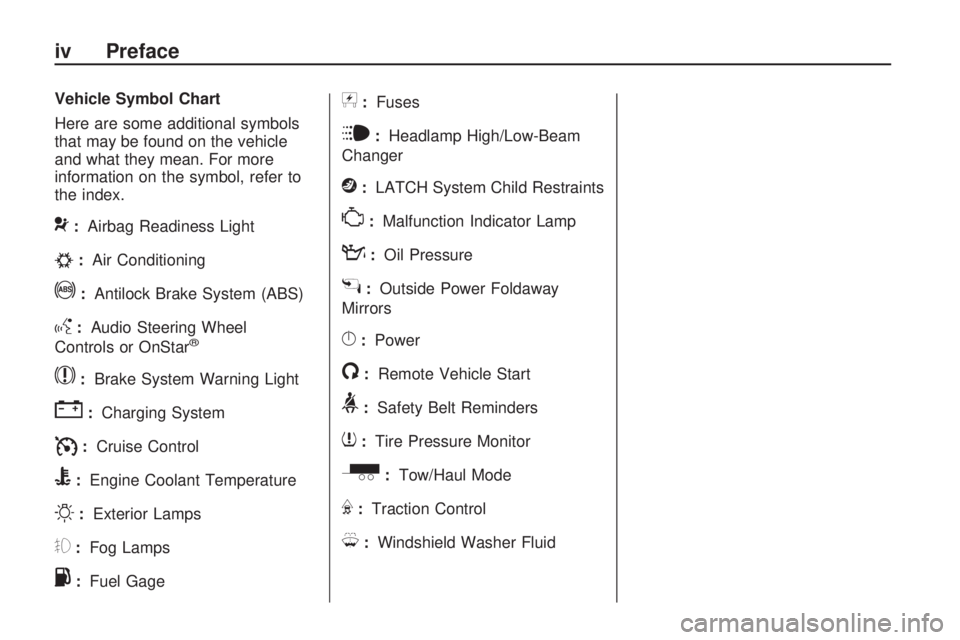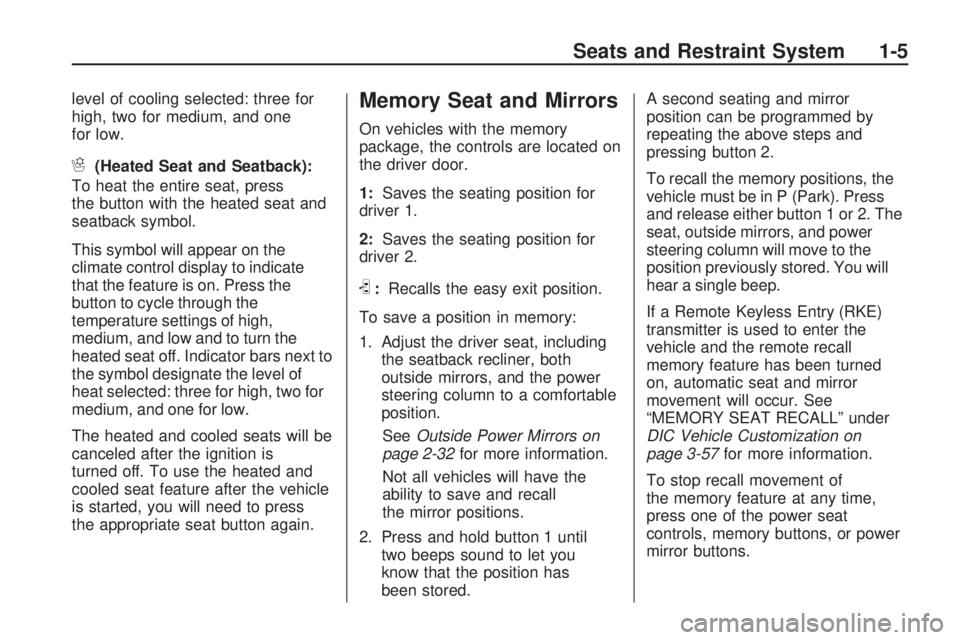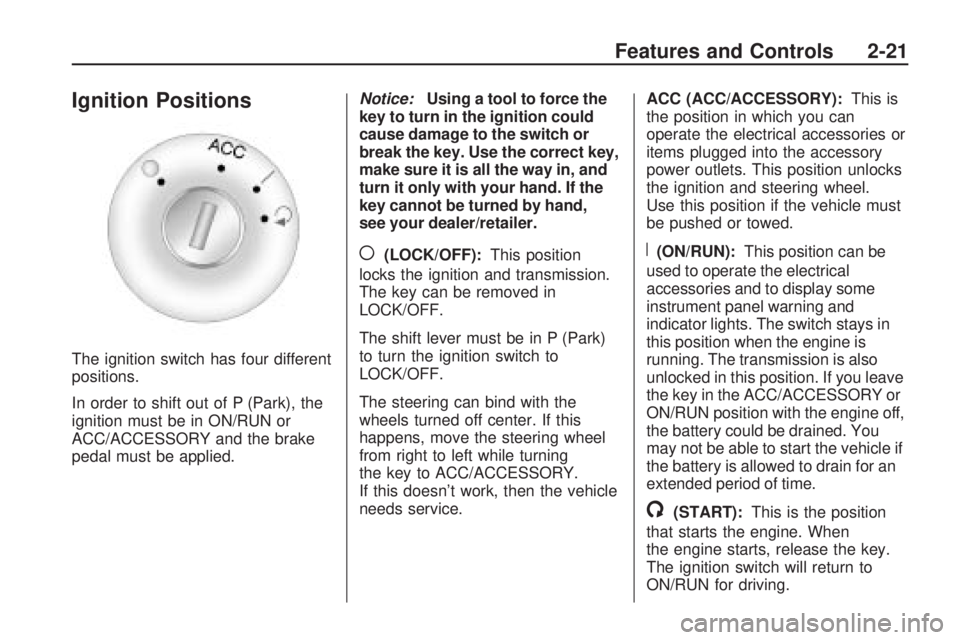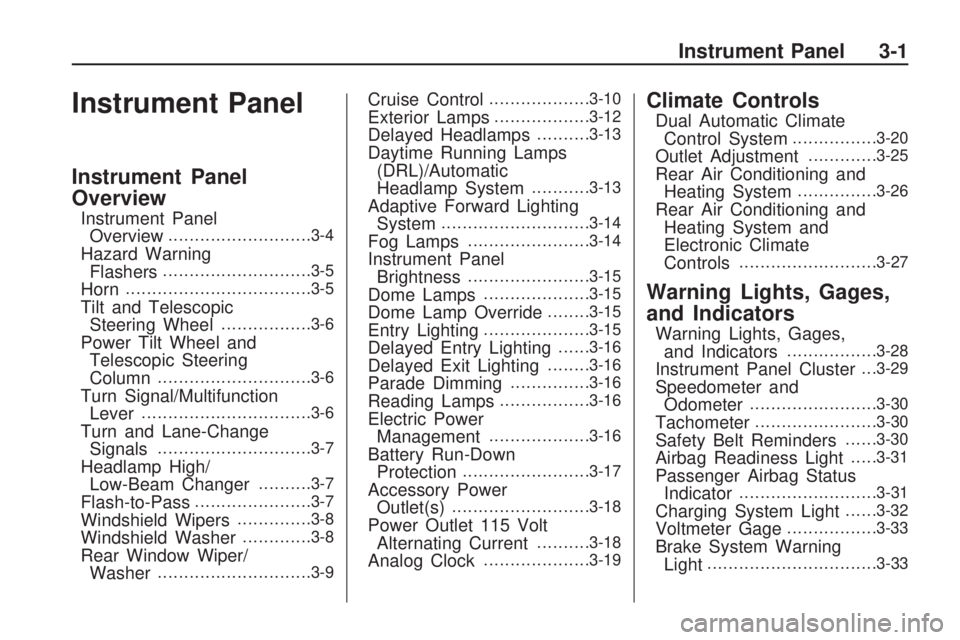steering BUICK ENCLAVE 2009 Owner's Manual
[x] Cancel search | Manufacturer: BUICK, Model Year: 2009, Model line: ENCLAVE, Model: BUICK ENCLAVE 2009Pages: 412
Page 4 of 412

Vehicle Symbol Chart
Here are some additional symbols
that may be found on the vehicle
and what they mean. For more
information on the symbol, refer to
the index.
9:Airbag Readiness Light
#:Air Conditioning
!:Antilock Brake System (ABS)
g:Audio Steering Wheel
Controls or OnStar®
$:Brake System Warning Light
":Charging System
I:Cruise Control
B:Engine Coolant Temperature
O:Exterior Lamps
#:Fog Lamps
.:Fuel Gage
+:Fuses
i:Headlamp High/Low-Beam
Changer
j:LATCH System Child Restraints
*:Malfunction Indicator Lamp
::Oil Pressure
g:Outside Power Foldaway
Mirrors
}:Power
/:Remote Vehicle Start
>:Safety Belt Reminders
7:Tire Pressure Monitor
_:Tow/Haul Mode
F:Traction Control
M:Windshield Washer Fluid
iv Preface
Page 9 of 412

level of cooling selected: three for
high, two for medium, and one
for low.
H(Heated Seat and Seatback):
To heat the entire seat, press
the button with the heated seat and
seatback symbol.
This symbol will appear on the
climate control display to indicate
that the feature is on. Press the
button to cycle through the
temperature settings of high,
medium, and low and to turn the
heated seat off. Indicator bars next to
the symbol designate the level of
heat selected: three for high, two for
medium, and one for low.
The heated and cooled seats will be
canceled after the ignition is
turned off. To use the heated and
cooled seat feature after the vehicle
is started, you will need to press
the appropriate seat button again.
Memory Seat and Mirrors
On vehicles with the memory
package, the controls are located on
the driver door.
1:Saves the seating position for
driver 1.
2:Saves the seating position for
driver 2.
S:Recalls the easy exit position.
To save a position in memory:
1. Adjust the driver seat, including
the seatback recliner, both
outside mirrors, and the power
steering column to a comfortable
position.
SeeOutside Power Mirrors on
page 2-32for more information.
Not all vehicles will have the
ability to save and recall
the mirror positions.
2. Press and hold button 1 until
two beeps sound to let you
know that the position has
been stored.A second seating and mirror
position can be programmed by
repeating the above steps and
pressing button 2.
To recall the memory positions, the
vehicle must be in P (Park). Press
and release either button 1 or 2. The
seat, outside mirrors, and power
steering column will move to the
position previously stored. You will
hear a single beep.
If a Remote Keyless Entry (RKE)
transmitter is used to enter the
vehicle and the remote recall
memory feature has been turned
on, automatic seat and mirror
movement will occur. See
“MEMORY SEAT RECALL” under
DIC Vehicle Customization on
page 3-57for more information.
To stop recall movement of
the memory feature at any time,
press one of the power seat
controls, memory buttons, or power
mirror buttons.
Seats and Restraint System 1-5
Page 49 of 412

Airbag System
The vehicle has the following
airbags:
A frontal airbag for the driver.
A frontal airbag for the right front
passenger.
A seat-mounted side impact
airbag for the driver.
A seat-mounted side impact
airbag for the right front
passenger.
A roof-rail airbag for the driver,
passenger seated directly
behind the driver, and the third
row outboard passenger position.
A roof-rail airbag for the right
front passenger, passenger
seated directly behind the right
front passenger, and the third row
outboard passenger position.All of the airbags in the vehicle will
have the word AIRBAG embossed
in the trim or on an attached
label near the deployment opening.
For frontal airbags, the word
AIRBAG will appear on the middle
part of the steering wheel for
the driver and on the instrument
panel for the right front passenger.
With seat-mounted side impact
airbags, the word AIRBAG
will appear on the side of the
seatback closest to the door.
With roof-rail airbags, the word
AIRBAG will appear along the
headliner or trim.
Airbags are designed to supplement
the protection provided by safety
belts. Even though today’s airbags
are also designed to help reduce
the risk of injury from the force of an
in�ating bag, all airbags must
in�ate very quickly to do their job.Here are the most important things
to know about the airbag system:
{CAUTION
You can be severely injured or
killed in a crash if you are not
wearing your safety belt — even if
you have airbags. Airbags are
designed to work with safety
belts, but do not replace them.
Also, airbags are not designed to
deploy in every crash. In some
crashes safety belts are your only
restraint. SeeWhen Should an
Airbag Inflate? on page 1-48.
Wearing your safety belt during a
crash helps reduce your chance
of hitting things inside the vehicle
or being ejected from it. Airbags
are “supplemental restraints” to
the safety belts. Everyone in your
vehicle should wear a safety belt
properly — whether or not there is
an airbag for that person.
Seats and Restraint System 1-45
Page 51 of 412

Where Are the Airbags?
The driver frontal airbag is in the
middle of the steering wheel.The right front passenger frontal
airbag is in the instrument panel on
the passenger side.
The seat-mounted side impact
airbags for the driver and right front
passenger are in the side of the
seatbacks closest to the door.
Driver Side shown, Passenger
Side similar
Seats and Restraint System 1-47
Page 52 of 412

The roof-rail airbags for the driver,
right front passenger, passengers
behind the driver and right front
passenger, and the third row
outboard passengers are in the
ceiling above the side windows.
{CAUTION
If something is between an
occupant and an airbag, the
airbag might not in�ate properly or
it might force the object into that
person causing severe injury or
even death. The path of an
in�ating airbag must be kept
clear. Do not put anything
between an occupant and an
airbag, and do not attach or put
anything on the steering wheel
hub or on or near any other
airbag covering.
Do not use seat accessories that
block the in�ation path of a
seat-mounted side impact airbag.
Never secure anything to the roof
of a vehicle with roof-rail airbags
by routing a rope or tie down
through any door or window
opening. If you do, the path of an
in�ating roof-rail airbag will be
blocked.
When Should an Airbag
In�ate?
Frontal airbags are designed to
in�ate in moderate to severe frontal
or near-frontal crashes to help
reduce the potential for severe
injuries mainly to the driver’s or right
front passenger’s head and chest.
However, they are only designed to
in�ate if the impact exceeds a
predetermined deployment
threshold. Deployment thresholds
are used to predict how severe
a crash is likely to be in time for the
airbags to in�ate and help restrain
the occupants.
Whether the frontal airbags will or
should deploy is not based on
how fast your vehicle is traveling. It
depends largely on what you hit,
the direction of the impact, and how
quickly your vehicle slows down. Driver Side shown, Passenger
Side similar
1-48 Seats and Restraint System
Page 54 of 412

is determined by the location and
severity of the side impact. In
a rollover event, roof-rail airbag
deployment is determined by
the direction of the roll.
What Makes an Airbag
In�ate?
In a deployment event, the sensing
system sends an electrical signal
triggering a release of gas from the
in�ator. Gas from the in�ator �lls
the airbag causing the bag to break
out of the cover and deploy. The
in�ator, the airbag, and related
hardware are all part of the airbag
module.
Frontal airbag modules are located
inside the steering wheel and
instrument panel. For vehicles with
seat-mounted side impact airbags,
there are airbag modules in the side
of the front seatbacks closest to
the door. For vehicles with roof-rail
airbags, there are airbag modulesin the ceiling of the vehicle, near the
side windows that have occupant
seating positions.
How Does an Airbag
Restrain?
In moderate to severe frontal or
near frontal collisions, even belted
occupants can contact the steering
wheel or the instrument panel.
In moderate to severe side
collisions, even belted occupants
can contact the inside of the vehicle.
Airbags supplement the protection
provided by safety belts.
Frontal airbags distribute the force
of the impact more evenly over
the occupant’s upper body, stopping
the occupant more gradually.
Seat-mounted side impact and
roof-rail airbags distribute the force
of the impact more evenly over
the occupant’s upper body.Rollover capable roof-rail airbags
are designed to help contain
the head and chest of occupants in
the outboard seating positions in
the �rst, second, and third rows. The
rollover capable roof-rail airbags
are designed to help reduce the risk
of full or partial ejection in rollover
events, although no system can
prevent all such ejections.
But airbags would not help in many
types of collisions, primarily
because the occupant’s motion is
not toward those airbags. SeeWhen
Should an Airbag Inflate? on
page 1-48for more information.
Airbags should never be regarded
as anything more than a supplement
to safety belts.
1-50 Seats and Restraint System
Page 61 of 412

Adding Equipment to
Your Airbag-Equipped
Vehicle
Q:Is there anything I might add
to or change about the
vehicle that could keep the
airbags from working
properly?
A:Yes. If you add things that
change the vehicle’s frame,
bumper system, height, front end
or side sheet metal, they may
keep the airbag system from
working properly. Changing or
moving any parts of the front
seats, safety belts, the airbag
sensing and diagnostic module,
steering wheel, instrument
panel, roof-rail airbag modules,
ceiling headliner or pillar
garnish trim, front sensors, side
impact sensors, rolloversensor module, or airbag wiring
can affect the operation of
the airbag system.
In addition, the vehicle has a
passenger sensing system
for the right front passenger
position, which includes sensors
that are part of the passenger
seat. The passenger sensing
system may not operate properly
if the original seat trim is
replaced with non-GM covers,
upholstery or trim, or with
GM covers, upholstery or trim
designed for a different vehicle.
Any object, such as an
aftermarket seat heater or a
comfort enhancing pad or device,
installed under or on top of the
seat fabric, could also interfere
with the operation of the
passenger sensing system. This
could either prevent properdeployment of the passenger
airbag(s) or prevent the
passenger sensing system from
properly turning off the
passenger airbag(s). See
Passenger Sensing System on
page 1-52.
If you have questions, call
Customer Assistance. The phone
numbers and addresses for
Customer Assistance are in Step
Two of the Customer Satisfaction
Procedure in this manual. See
Customer Satisfaction Procedure
on page 7-1.
If the vehicle has rollover
roof-rail airbags, seeDifferent
Size Tires and Wheels on
page 5-52for additional
important information.
Seats and Restraint System 1-57
Page 85 of 412

Ignition Positions
The ignition switch has four different
positions.
In order to shift out of P (Park), the
ignition must be in ON/RUN or
ACC/ACCESSORY and the brake
pedal must be applied.Notice:Using a tool to force the
key to turn in the ignition could
cause damage to the switch or
break the key. Use the correct key,
make sure it is all the way in, and
turn it only with your hand. If the
key cannot be turned by hand,
see your dealer/retailer.
((LOCK/OFF):This position
locks the ignition and transmission.
The key can be removed in
LOCK/OFF.
The shift lever must be in P (Park)
to turn the ignition switch to
LOCK/OFF.
The steering can bind with the
wheels turned off center. If this
happens, move the steering wheel
from right to left while turning
the key to ACC/ACCESSORY.
If this doesn’t work, then the vehicle
needs service.ACC (ACC/ACCESSORY):This is
the position in which you can
operate the electrical accessories or
items plugged into the accessory
power outlets. This position unlocks
the ignition and steering wheel.
Use this position if the vehicle must
be pushed or towed.R(ON/RUN):This position can be
used to operate the electrical
accessories and to display some
instrument panel warning and
indicator lights. The switch stays in
this position when the engine is
running. The transmission is also
unlocked in this position. If you leave
the key in the ACC/ACCESSORY or
ON/RUN position with the engine off,
the battery could be drained. You
may not be able to start the vehicle if
the battery is allowed to drain for an
extended period of time.
/(START):This is the position
that starts the engine. When
the engine starts, release the key.
The ignition switch will return to
ON/RUN for driving.
Features and Controls 2-21
Page 107 of 412

Verizon Wireless service plan in the
U.S. or a Bell Mobility service
plan in Canada, depending on
eligibility. To �nd out more, refer to
the OnStar Owner’s Guide in
the vehicle’s glove box, visit
onstar.com or onstar.ca, or speak
with an OnStar advisor by pressing
the OnStar button or calling
1-888-4-ONSTAR (1-888-466-7827).
OnStar Turn-by-Turn
Navigation
Vehicles with the OnStar
Turn-by-Turn Navigation system
can provide voice-guided driving
directions. Press the OnStar button
to have an OnStar advisor locate
a business or address and download
driving directions to the vehicle.
Voice-guided directions to the
desired destination will play through
the audio system speakers. See
the OnStar Owner’s Guide for more
information.
OnStar Virtual Advisor
OnStar Virtual Advisor is a feature of
OnStar Hands-Free Calling that uses
minutes to access location-based
weather, local traffic reports, and
stock quotes. Press the phone button
and give a few simple voice
commands to browse through the
various topics. See the OnStar
Owner’s Guide for more information.
This feature is only available in the
continental U.S.
OnStar Steering Wheel
Controls
This vehicle may have a Talk/Mute
button that can be used to
interact with OnStar Hands-Free
Calling. SeeAudio Steering Wheel
Controls on page 3-113for more
information.
On some vehicles, the mute button
can be used to dial numbers into
voice mail systems, or to dial phone
extensions. See the OnStar Owner’s
Guide for more information.
How OnStar Service Works
The OnStar system can record
and transmit vehicle information.
This information is automatically
sent to an OnStar Call Center when
the OnStar button is pressed, the
emergency button is pressed,
or if the airbags or AACN system
deploy. This information usually
includes the vehicle’s GPS location
and, in the event of a crash,
additional information regarding
the crash that the vehicle was
involved in (e.g. the direction from
which the vehicle was hit). When the
Virtual Advisor feature of OnStar
Hands-Free Calling is used,
the vehicle also sends OnStar the
vehicle’s GPS location so they
can provide services where
it is located.
Features and Controls 2-43
Page 119 of 412

Instrument Panel
Instrument Panel
Overview
Instrument Panel
Overview...........................3-4
Hazard Warning
Flashers............................3-5
Horn...................................3-5
Tilt and Telescopic
Steering Wheel.................3-6
Power Tilt Wheel and
Telescopic Steering
Column
.............................3-6
Turn Signal/Multifunction
Lever................................3-6
Turn and Lane-Change
Signals.............................3-7
Headlamp High/
Low-Beam Changer..........3-7
Flash-to-Pass......................3-7
Windshield Wipers..............3-8
Windshield Washer.............3-8
Rear Window Wiper/
Washer.............................3-9
Cruise Control...................3-10
Exterior Lamps..................3-12
Delayed Headlamps..........3-13
Daytime Running Lamps
(DRL)/Automatic
Headlamp System
...........3-13
Adaptive Forward Lighting
System............................3-14
Fog Lamps.......................3-14
Instrument Panel
Brightness.......................3-15
Dome Lamps....................3-15
Dome Lamp Override........3-15
Entry Lighting....................3-15
Delayed Entry Lighting......3-16
Delayed Exit Lighting........3-16
Parade Dimming...............3-16
Reading Lamps.................3-16
Electric Power
Management...................3-16
Battery Run-Down
Protection........................3-17
Accessory Power
Outlet(s)..........................3-18
Power Outlet 115 Volt
Alternating Current..........3-18
Analog Clock....................3-19
Climate Controls
Dual Automatic Climate
Control System................3-20
Outlet Adjustment.............3-25
Rear Air Conditioning and
Heating System...............3-26
Rear Air Conditioning and
Heating System and
Electronic Climate
Controls
..........................3-27
Warning Lights, Gages,
and Indicators
Warning Lights, Gages,
and Indicators.................3-28
Instrument Panel Cluster. . .3-29
Speedometer and
Odometer........................3-30
Tachometer.......................3-30
Safety Belt Reminders......3-30
Airbag Readiness Light.....3-31
Passenger Airbag Status
Indicator..........................3-31
Charging System Light......3-32
Voltmeter Gage.................3-33
Brake System Warning
Light................................3-33
Instrument Panel 3-1